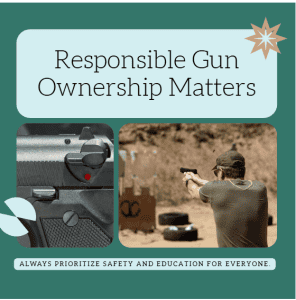 Responsible Gun Ownership: Best Practices for Storage, Handling, and Cleaning
Responsible Gun Ownership: Best Practices for Storage, Handling, and Cleaning
Being a responsible gun owner goes beyond just purchasing a firearm. It’s about ensuring that your weapon is safely stored, properly handled, and regularly maintained. Here’s a guide to help you maintain the highest standards of safety and responsibility:
1. Gun Storage Best Practices
Proper storage of firearms is crucial to ensuring safety in your home, preventing unauthorized access, and avoiding accidents. Here’s what you should consider when storing firearms:
- Secure Storage Locations:
- Lockable Gun Safe: The best option for firearm storage. A high-quality, fire-resistant, and burglar-proof safe is ideal. Make sure it’s securely anchored to the ground or walls to prevent theft.
- Gun Cabinets: While not as secure as safes, lockable cabinets provide basic security. If you go this route, consider adding extra layers like lockboxes inside the cabinet.
- Trigger Locks and Cable Locks:
- For added security, consider using trigger locks or cable locks. These can help prevent a firearm from being used even if it’s not stored in a safe.
- Separate Ammunition Storage:
- Store ammunition in a separate, locked location away from the firearm itself. This reduces the risk of accidents if unauthorized individuals gain access to your firearms.
- Humidity Control:
- Guns are susceptible to rust and corrosion, so keep your storage area dry. Consider using silica gel packs or a dehumidifier to maintain an ideal humidity level (ideally below 50%).
- Out of Reach of Children:
- Never store firearms where children can access them. Make sure all safety measures are taken to ensure that young ones cannot easily access the safe or gun cabinet.
2. Safe Handling of Firearms
Proper handling is critical to avoid accidents, and there are four main rules that should always be followed:
The Four Rules of Gun Safety (Always follow these when handling any firearm):
- Treat every firearm as if it’s loaded.
- Always assume a gun is loaded until you personally check to ensure it’s not. This avoids any accidental discharges.
- Never point the muzzle at anything you’re not willing to destroy.
- Always keep the muzzle pointed in a safe direction, whether you’re using the firearm or simply handling it.
- Keep your finger off the trigger until you’re ready to shoot.
- Only put your finger on the trigger when you’ve made the decision to fire. Always keep your finger outside the trigger guard until ready to shoot.
- Be sure of your target and what’s beyond it.
- Before firing, ensure you have identified the target clearly, and are aware of what’s behind it. A bullet can travel long distances and may have unintended consequences if it misses or passes through the target.
- Practice Dry Firing:
- Dry firing (without ammunition) is a great way to practice proper trigger control and sight alignment without risking an accidental discharge.
- Loading and Unloading:
- Always load and unload your firearm in a controlled, safe environment. Double-check the chamber and magazine to ensure they are empty before handling.
3. Firearm Cleaning Best Practices
Keeping your firearm clean and well-maintained ensures that it functions properly, lasts longer, and is safe to use. Regular cleaning is essential for preventing malfunction and preserving your weapon.
- Frequency of Cleaning:
- Firearms used for self-defense or concealed carry should be cleaned at least once a month, even if you haven’t fired them. For range or hunting firearms, cleaning after each use is highly recommended.
- Basic Cleaning Kit:
- Invest in a high-quality firearm cleaning kit that includes:
- Cleaning rod (appropriate for your firearm’s caliber)
- Bore brush (for scrubbing the barrel)
- Cleaning patches (for wiping the barrel and chamber)
- Solvents and oils (to clean and lubricate)
- A soft brush (for cleaning parts like the slide or receiver)
- Microfiber cloth (to wipe down the exterior)
- Invest in a high-quality firearm cleaning kit that includes:
- Step-by-Step Cleaning Process:
- Unload the Firearm: Ensure the firearm is unloaded, magazine removed, and the chamber is clear before beginning.
- Disassemble the Firearm: Follow the manufacturer’s guidelines to break the gun down for cleaning. Pay close attention to how parts fit together for reassembly.
- Clean the Barrel: Use the bore brush and solvent to scrub the inside of the barrel. This removes fouling and deposits left behind by gunpowder and lead.
- Wipe Down Other Parts: Use a microfiber cloth to clean the frame, slide, and other components, ensuring no debris or dirt is left behind.
- Lubricate: After cleaning, apply a small amount of oil to the moving parts to ensure proper functioning. Wipe away any excess oil to avoid attracting dust.
- Reassemble: Once the firearm is cleaned and lubricated, reassemble it carefully and perform a function check to ensure everything works properly.
- Avoid Over-Cleaning:
- While regular cleaning is important, excessive cleaning (especially overuse of solvents or scrubbing) can damage the firearm’s finish and internal components. Stick to manufacturer recommendations.
- Storage After Cleaning:
- After cleaning, store the firearm in a safe, dry place. Avoid leaving guns exposed to moisture, which can lead to rust or corrosion.
4. Firearm Maintenance and Inspection
Regular maintenance checks are just as important as cleaning. Here are some additional steps for keeping your firearm in top shape:
- Inspect for Wear and Tear:
- Periodically check for signs of wear, such as cracked grips, worn-out springs, or loose parts. Replace any damaged components immediately to prevent malfunctions.
- Check Sights and Optics:
- Ensure your sights or optics are securely attached and properly aligned. Misaligned sights can affect accuracy and reliability.
- Spring Tension:
- Gun springs (like the recoil spring) wear out over time. It’s a good practice to replace springs after a certain number of rounds or based on the manufacturer’s recommended schedule.
- Test Fire:
- If possible, periodically take your firearm to the range and test fire it. This helps you ensure that it’s still functioning properly and that you remain familiar with its handling.
5. Firearm Training
A firearm is only as good as the person who handles it. Regular training is essential for responsible gun ownership.
- Seek Professional Training:
- Taking professional courses in firearm handling, safety, and self-defense can help you better understand how to use and care for your firearm.
- Stay Informed on Gun Laws:
- Gun laws vary by location and are subject to change. Stay informed about local and federal regulations to ensure that you’re compliant with the law.
Conclusion:
Being a responsible gun owner is about more than just keeping a firearm for personal protection; it’s about ensuring safety, proper care, and respect for the weapon and the surrounding community. By following these storage, handling, and cleaning best practices, you’ll not only keep your firearm in excellent working order, but you’ll also demonstrate responsible gun ownership to others.
